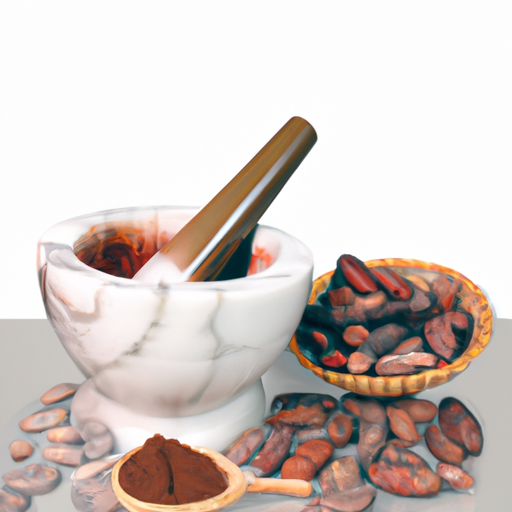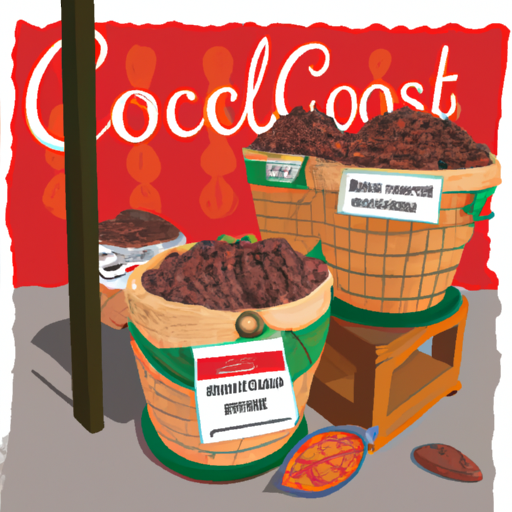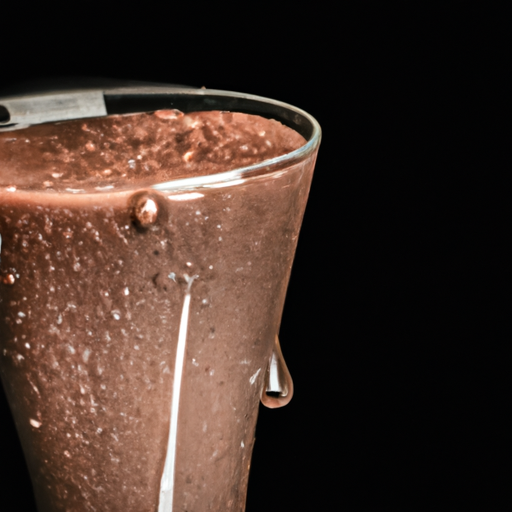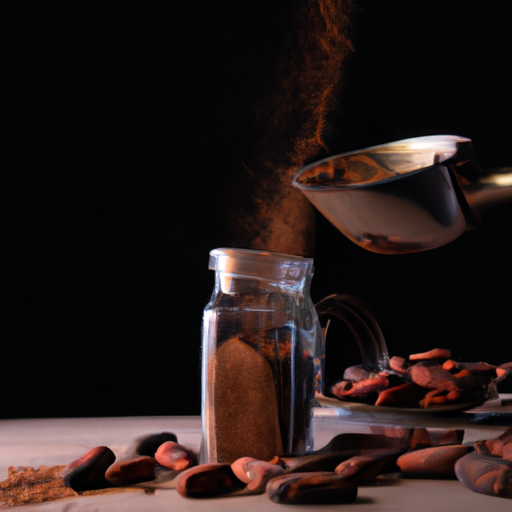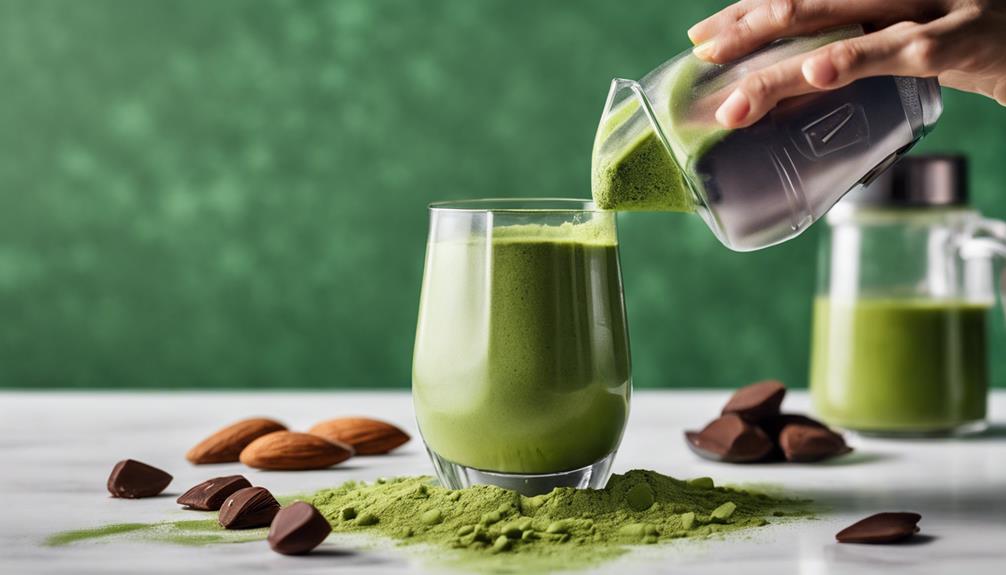As a fan of chocolate, I have always been intrigued by the complex process of turning cacao beans into delicious treats. Creating raw cacao paste feels like discovering a secret trove of flavors and potential. It’s akin to being a kitchen wizard, meticulously choosing the best cacao beans and expertly blending them into a smooth paste that is luxurious and satisfying.
In this article, I will guide you through the step-by-step process of making raw cacao paste. Using scientific research and evidence-based techniques, I will ensure that you have accurate measurements and instructions to create the perfect batch.
We will delve into the nutritional composition of cacao paste, exploring its macronutrients and micronutrients, as well as its potential health benefits. I will also address any health considerations, from allergenicity to dietary recommendations.
So, let’s embark on this culinary adventure and uncover the secrets of making raw cacao paste – a true delight for the senses and a treat for the body.
Key Takeaways
- Cacao paste adds depth and richness to recipes
- Cacao paste enhances flavor and nutritional value
- Cacao paste can be added to smoothies, energy balls, and homemade chocolate bars
- Storing cacao paste properly in a cool, dry place and protecting it from air exposure extends its shelf life and maintains its quality.
Selecting the Right Cacao Beans
Choosing the appropriate cacao beans is crucial when aiming to create a high-quality raw cacao paste. To ensure the best results, it’s recommended to choose organic cacao beans. Organic beans are grown without the use of synthetic pesticides or fertilizers, which can affect the flavor and quality of the final product.
Additionally, understanding different cacao bean varieties is important. There are various types of cacao beans, each with its own unique flavor profile and characteristics. Some popular varieties include Criollo, Forastero, and Trinitario. Each variety has its own distinct taste and aroma, allowing you to experiment and find the perfect beans for your raw cacao paste.
Now that we have selected the right cacao beans, let’s move on to the next step: fermenting and drying the beans.
Fermenting and Drying the Beans
After carefully selecting the ripe cacao beans, it’s time to let them ferment and dry, just like grapes transform into wine.
Fermentation is a crucial step in the cacao bean processing, as it helps develop the unique flavors and aromas of raw cacao paste. During fermentation, the beans are placed in large wooden boxes or covered containers for several days. This allows the natural yeasts and bacteria on the bean’s surface to break down the sugars and convert them into alcohol and acids.
The temperature and humidity are carefully controlled to ensure optimal fermentation.
Following fermentation, the beans are spread out to dry in the sun or using low-temperature ovens. This drying process further enhances the flavors and reduces moisture content, making the beans easier to grind into a smooth paste.
Fermenting and drying the beans is a vital step in the journey to create high-quality raw cacao paste with its unique taste and health benefits.
Once the beans are dried, they are ready for the next step: roasting.
Roasting the Cacao Beans
Once the beans have undergone fermentation and drying, they’re then ready to be roasted, enhancing their flavors and aromas.
Roasting is a crucial step in the process of making raw cacao paste, as it helps develop the characteristic flavor profiles we associate with chocolate. The roasting technique can vary depending on personal preference and desired flavor intensity.
Generally, the beans are roasted at temperatures around 250°F (120°C) for approximately 20-30 minutes. This process causes the beans to darken and release their natural oils, resulting in a rich and complex taste. However, it’s important to note that over-roasting can lead to a bitter flavor.
Once the roasting is complete, the next step involves removing the cacao nibs, which will be discussed in the subsequent section.
Removing the Cacao Nibs
To get those precious cacao nibs, all you need to do is separate them from the outer husk of the bean – it’s like a treasure hunt, but with chocolate! There are several methods to remove the cacao nibs from the husk.
One common method is called winnowing, where the roasted beans are cracked and then the nibs are separated from the husk by blowing air or using a sieve.
Another method involves manually peeling the husk off the nibs. Once the nibs are separated, they can be used to make raw cacao paste. The benefits of consuming raw cacao paste are numerous. It is rich in antioxidants, which can help protect against oxidative stress and inflammation in the body. It also contains essential minerals like magnesium, iron, and zinc.
Incorporating raw cacao paste into a balanced diet can be a delicious and nutritious way to boost overall health.
Now that we have the cacao nibs, let’s move on to the next step of grinding them into a smooth paste.
Grinding the Cacao Nibs
Now that we have the precious cacao nibs, it’s time to transform them into a velvety-smooth chocolatey delight by grinding them. To achieve the perfect texture, you will need a grinder or food processor. Make sure the grinder is specifically designed for grinding nuts and seeds, as cacao nibs are quite hard. Alternatively, a mortar and pestle can be used, although it requires more time and effort.
Grind the cacao nibs in short bursts to prevent overheating and ensure even grinding. The goal is to create a fine powder or a smooth paste, depending on your preference. This process typically takes around 5-10 minutes, depending on the equipment used.
Once the cacao nibs have been ground to your desired consistency, you can move on to the next step of adding sweeteners or flavorings (optional).
Adding Sweeteners or Flavorings (Optional)
After grinding the cacao nibs into a smooth chocolatey delight, you can enhance the flavor by adding your choice of sweeteners or flavorings. Options like honey or vanilla extract can be used to create a decadent treat.
Sweeteners: The addition of natural sweeteners like honey or maple syrup not only adds a touch of sweetness but also provides additional nutrients and health benefits. These sweeteners are a healthier alternative to refined sugar, as they contain antioxidants and minerals that support overall well-being.
Flavorings: Vanilla extract or other natural flavorings can be added to the cacao paste to enhance its taste and aroma. These flavorings add depth and complexity to the chocolatey flavor, making it even more enjoyable.
Raw cacao paste itself already offers a plethora of health benefits. It is rich in antioxidants, which help protect the body against oxidative stress and inflammation. Cacao paste also contains essential minerals like magnesium, iron, and zinc, which support various bodily functions and promote overall health. Additionally, it is a good source of dietary fiber and healthy fats.
When incorporating raw cacao paste into your diet, it is important to consider certain health considerations. Some individuals may be allergic to cacao, so it’s essential to check for any potential allergic reactions. Additionally, cacao contains caffeine and theobromine, which can have stimulating effects. If you have specific health conditions or take medications, it’s advisable to consult with a healthcare professional before consuming raw cacao paste.
Now that you have added your desired sweeteners or flavorings, the next step is to melt the cacao paste for further processing.
Melting the Cacao Paste
Once you’ve transformed the smooth chocolatey delight, it’s time to melt it down for further processing.
When melting cacao paste, it’s important to choose the right type of cacao butter. Different types can vary in flavor and consistency, so selecting the one that best suits your taste preferences is crucial.
There are various techniques you can use to melt the cacao paste. One popular method is to gently heat it in a double boiler. This involves placing the paste in a heatproof bowl and setting it over a pot of simmering water. It’s important to ensure that the water in the bottom pot does not come into direct contact with the cacao paste. This slow and controlled melting process helps to preserve the delicate flavors and nutrients in the paste.
Another technique is to use a microwave. Simply place the cacao paste in a microwave-safe bowl and heat it in short intervals. It’s important to stir in between to avoid overheating.
Once the cacao paste is melted, it can be used in a variety of recipes, adding depth and richness to your culinary creations.
Using the Cacao Paste in Recipes
Explore the endless possibilities of incorporating this velvety, luscious ingredient into your favorite desserts and confections.
Using cacao paste as a healthy alternative, you can enhance the flavor and nutritional value of your treats. Cacao paste is rich in macronutrients like carbohydrates, fats, and proteins, providing energy and satiety. It also contains micronutrients such as vitamins and minerals, including magnesium and iron, which contribute to overall health. The antioxidants present in cacao paste may have a positive impact on cardiovascular health and reduce inflammation.
However, it is important to consider potential allergenicity and interactions with medications before indulging. Pregnant women and individuals with specific health conditions should consult their healthcare provider.
To incorporate cacao paste into a balanced diet, try adding it to smoothies, energy balls, or homemade chocolate bars. Discover the delicious ways to enjoy cacao paste while reaping its health benefits.
Moving on to storing and preserving the cacao paste…
Storing and Preserving the Cacao Paste
Now that you know how to use cacao paste in recipes, let’s talk about the importance of storing and preserving it properly. Proper storage is crucial to maintain the quality and extend the shelf life of the cacao paste. Here are some key tips to keep in mind:
-
Store in a cool, dry place: Cacao paste should be kept away from heat, moisture, and direct sunlight to prevent it from melting or developing mold.
-
Use airtight containers: Transfer the cacao paste into airtight containers or resealable bags to protect it from air exposure, which can lead to oxidation and flavor deterioration.
-
Refrigerate for longer shelf life: If you want to extend the shelf life of your cacao paste, refrigeration is recommended. It can help maintain its freshness and prevent rancidity.
-
Check for signs of spoilage: Before using the cacao paste, always check for any signs of spoilage, such as off odors, discoloration, or mold growth. If you notice any of these, it’s best to discard the paste to avoid any potential health risks.
By following these storage guidelines, you can enjoy the rich flavors and benefits of cacao paste for an extended period.
Frequently Asked Questions
How long does it take for cacao beans to ferment and dry?
The fermentation duration of cacao beans ranges from 2 to 7 days, while drying time can take up to 2 weeks. These processes are crucial for developing the distinct flavors and aromas of raw cacao paste.
Can I use any type of sweetener when making cacao paste?
When making cacao paste, there are various alternative sweeteners you can use. Each sweetener has its own health benefits, such as providing antioxidants or being low in calories. It’s important to consider these benefits when choosing a sweetener for cacao paste.
Can I add flavorings to the cacao paste during the grinding process?
Yes, you can add flavorings to cacao paste during the grinding process. However, it is important to consider the pros and cons. Flavorings can enhance the taste, but they may also alter the nutritional composition and potential health benefits of the cacao paste.
What is the best way to melt the cacao paste?
The best way to melt cacao paste is by gently heating it to around 104-113°F (40-45°C). Different melting methods can be used, such as a double boiler or a microwave.
How long can I store the cacao paste before it goes bad?
The shelf life of cacao paste varies, but it can typically be stored for up to two years if properly stored in a cool, dry place. To extend its shelf life, store it in an airtight container.
Can I Make Raw Cacao Paste at Home?
Yes, you can make raw cacao paste at home. Simply blend raw cacao nibs until they form a smooth, thick paste. The paste can be used in various recipes or as a base for homemade chocolate. Raw cacao paste explained is a versatile and delicious ingredient for any chocolate lover.
Conclusion
Making raw cacao paste involves several steps to ensure its quality and flavor. Here is a breakdown of the process:
-
Start by selecting high-quality cacao beans. Look for beans that are organic and sustainably sourced.
-
Fermentation is a crucial step in developing the flavor of the cacao. After harvesting the beans, let them ferment for a few days in a controlled environment. This process enhances the natural flavors and reduces bitterness.
-
Once the fermentation is complete, the beans need to be dried. Spread them out in a single layer and let them dry naturally under the sun or use a dehydrator. This step removes excess moisture and prepares the beans for roasting.
-
Roasting the beans brings out their rich aroma and deepens the flavor. Preheat your oven to a low temperature and spread the dried beans on a baking sheet. Roast them for about 20-30 minutes, stirring occasionally, until they are fragrant and slightly crunchy.
-
After roasting, allow the beans to cool before grinding them. You can use a high-quality grinder or a food processor to achieve a smooth consistency. Grind the beans in small batches to ensure even grinding.
-
The resulting cacao mass can be used as is, or you can further process it into cacao paste. To do this, heat the cacao mass gently in a double boiler until it melts into a smooth, liquid consistency. Be careful not to overheat it, as this can affect the flavor and texture.
-
Once the cacao mass has melted, pour it into molds or a container and let it cool and solidify. You now have homemade raw cacao paste ready to use in your recipes!
Remember to store the cacao paste in an airtight container in a cool, dark place to preserve its freshness and quality. Enjoy experimenting with this versatile ingredient in your favorite chocolate recipes or as a nutritious addition to smoothies and desserts.

